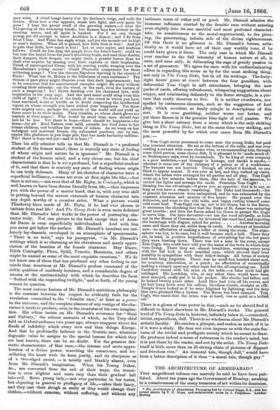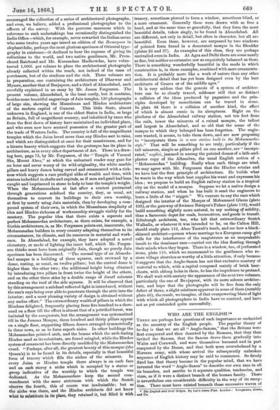THE ARCHITECTURE OF AHMEDABAD.* THIS magnificent volume can scarcely be
said to have been pub- lished. About ten years ago the Government of Bombay, awaking to a consciousness of the many treasures of art within its dominion,
• The Architecture of Ahmedabad. Photographed by Colonel Biggs, RA , with his- torical sketch by T. C. Hope, and architectural nom, by J. Fergus.son. LondOn: Murray. encouraged the collection of a series of architectural photographs, and even, we believe, added a professional photographer to the officers of the survey. With the perverse meanness which in reference to such undertakings has occasionally distinguished the India Office—which, for example, never rewarded the Italian savan who some twelve years ago issued an edition of the Ramayuna in elephant folio, perhaps the most glorious specimen of Oriental typo. graphy in existence—it declined to bear the expense of giving its collections to the world, and two native gentlemen, Mr. Prem- chund Rsichund and Mr. Kursondass Madhowdas, have volun- teered 1,000/. per volume to place the architectural photographs already collected within the reach, not indeed of the mass of purchasers, but of the studious and the rich. Three volumes are in preparation, one containing the architecture of Dharwar and Mysore, another that of Beejapoor, and a third of Ahmedabad, each carefully explained in an Essay by Mr. James Fergusson. The present volume, Ahmedabad, is the least costly, but it contains, besides some beautiful engravings of Jain temples, 120 photographs of large size, showing the Mussulman and Hindoo architecture of the modern capital of Guzemt. This little State, almost unknown in England, is one of the oldest States in India, as large as Britain, full of magnificent scenery, and inhabited by races who from the first dawn of history have maintained an individual place, and who even now have secured possession of the greater part of the trade of Western India. The country is full of the magnificent temples which the Jains loved more than any Hindoo sect to raise, and which are distinguished at once for their massiveness, and for a bizarre beauty which suggests that the grotesque has its place in architecture, as in every other department of Art. There is a draw- ing here, page 75, by Mr. Fergusson, of the "Temple of Veemul Sha, Mount Aboo," at which the unlearned reader may gaze for an hour and never weary of its wild originality, the white marble pillars and heavy domes being carved and ornamented with a rich- ness which suggests a race prodigal alike of wealth and time, with statues imbedded in shafts and capitals, as if men and genii had been caught and imprisoned in stone to help to bear the temple's weight. When the Mohammedans at last after a contest protracted through generations subdued the country, they, as usual, set themselves to convert its buildings to their own worship, at first by merely using Jain materials, then by developing a com- pound system of their own, in which the Mussulman simplicity of idea and Hindoo richness of workmanship struggle visibly for the mastery. The popular idea that there exists a separate and perfect Mohammedan architecture, as there exists, for example, a Gothic architecture, is, as Mr. Fergusson points out, inaccurate, the Mohammedan builders in every country adapting themselves to its circumstances, its climate, and its resources in material and work- men. In Ahmedabad, for example, they have adopted a novel clerestory, or mode of lighting the inner hall, which Mr. Fergus- son thinks must have been originally Jain, though no purely Jain specimen has been discovered. "The normal type of an Ahmeda- bad mosque is a building of three squares, each crowned by a dome, resting, as usual, on twelve pillars ; but the central dome is higher than the other two ; the additional height being obtained by introducing two pillars in front twice the height of the others, and on the other three sides by a double range of dwarf columns standing on the 'roof of the side squares. It will be observed that by this arrangement a subdued reflected light is introduced, without the sun's rays being ever able to penetrate through the attic into the interior; and a most pleasing variety of design is obtained without any undue effort." The extraordinary wealth of pillars in which the Hindoos delighted, frequently placing from five hundred to a thou- sand on a floor till the effect is almost that of a petrified forest, was imitated by the conquerors, but the arrangement was systematized till in the Jumma Mosque, three hundred and thirty pillars appear on a single floor, supporting fifteen domes arranged symmetrically ia three rows, so as to form superb aisles. In other buildings the Mohammedan pointed arch, and the beams which the arch-hating Hindoo used as its substitute, are found mingled, while the Hindoo system of ornament has been directly modified by the Mohammedan creed. "Perhaps, after all, the greatest beauty of this mosque (the Queen's) is to be found in its details, especially in that beautiful form of tracery which fills the niches of the minarets. In every Jaina or Hindoo temple there always is on each face and on each storey a niche which is occupied by a statue or group indicative of the worship to which the temple was dedicated. As the Mohammedans keep the second com- mandment with the same strictness with which the Scotch observe the fourth, this of course was inadmissible ; but as the niche was there, and the Hindoo architects did not know what to substitute in its place, they retained it, but filled it with
tracery, sometimes pierced to form a window, sometimes blind, as a mere ornament. Generally these were drawn with so free a hand, and at the same time so gracefully, that they form the most beautiful details, taken singly, to be found in Ahmedabad. All are different, not only in detail, but often in character, but all are beautiful. Even these, however, are surpassed by two windows of pointed form found in a desecrated mosque in the Bhudder (plates 36 and 37). As examples of this class, they are perhaps unrivalled even in India. At Agra and Delhi there are some nearly as fine, but neither so extensive nor so exquisitely balanced as these. There is something wonderfully beautiful in the mode in which construction is, in these examples, combined with mere ornamenta- tion. It is probably more like a work of nature than any other architectural detail that has yet been designed even by the best architects of Greece or of the middle ages."
It is very seldom that the genesis of a system of architec- ture can be so clearly traced, seldomer still that so distinct a collision of the ideas produced by paganism and the prin- ciples developed by monotheism can be traced in stone. In plate 88 there is a collision of another kind, the effect of which is almost comic in its abruptness. Right on the platform of the Ahmedabad railway station, not ten feet from the rails, tower the minarets of a ruined mosque, the tallest and largest in Ahmedabad, and so old that the name of the mosque to which they belonged has been forgotten. The engin- eers wanted, it seems, to take them down, and are now proposing to "incorporate them in a new station built in the Mohammedan style." That will be something to see truly, particularly if the tall minarets, simple as pillars piled on one another, are "incorpo- rated," anglia, jammed in among the pointed domes of a lath-and- plaster copy of the Alhambra, the usual English notion of a " Mohammedan " building. Really when such things are tried, we may agree with Mr. Fergusson that the Hindoo retains and we have lost the first principle of architecture. He builds what he wants in the way which best supplies his want and expresses his idea ; we propose to build an English railway station in a tropical city on the model of a mosque. Suppose we let a native design a railway station, and when he has built it send the engineers to learn a little of the "nigger." We venture to say the race which designed the interior of the Mosque of Mohammed Ghous (plate 103), or the gateway of Swimee Niirayen's Palace (plate 118), would build something slightly more natural, to say nothing solidity, than a Saracenic depot for coals, locomotives, and goods in transit. Edinburgh architects, too, who left that extraordinary Scotch Walhalla, or whatever it was intended to be, on the Calton Hill, should study plate 112, Aboo Toorab's tomb, and see how a black- skinned architect—person whose marriage to a European camp girl calls for the interference of the 'magistrates as an unspeakable insult to the dominant race—carried out the idea floating through their minds when they began. There is a window, too, of perforated stone, plate 110, which we recommend to the gentlemen who re- store village churches as worthy of a little attention, if only because it suggests that the Anglo-Saxon has not that exclusive mastery of material to which, with a capital composed mainly of brick beer- chests, with oblong holes in them, he has the impudence to pretend. We shall wait with anxiety the appearance of the next two volumes, particularly the one of Be ejapoor, with its more solemn architec- ture, and hope that the photographs will be free from the only defect of these, a slight mistiness apparent in some of them (notably plate 46), the result, we imagine, of that overpowering blaze of light with which all photographers in India have to contend, and have not as yet contended quite successfully.































 Previous page
Previous page